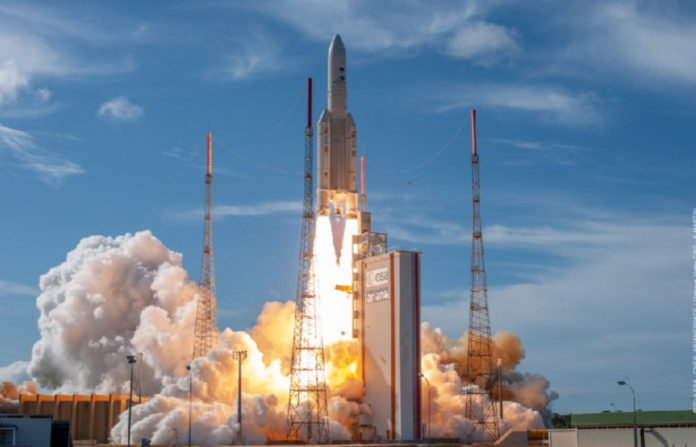For the third time of the year, Arianespace has successfully launched Ariane 5, a rocket that has placed three satellites in geostationary transfer orbit (GTO).
The three satellites include the B-SAT-4b satellite for the Japanese operator B-SAT, the Galaxy 30 satellite for the global operator Intelsat, and MEV-2 (Mission Extension Vehicle) for Space Logistics LLC, a wholly owned subsidiary of Northrop Grumman.
As a result of the performance continuous improvement program, the Ariane 5 launcher once again increased its payload capability on this flight by approximately 85 kg of additional payload, thanks to the use of a new optimized Vehicle Equipment Bay (VEB). Since 2016, Ariane 5 has increased its payload capacity to geostationary orbit by 300 kg.
“The summer sees Ariane 5 back in service, and more efficient than before, with even more payload capacity and carrying new significant parts produced using 3D printing. Seeing this year’s third Ariane 5 lift off, the first since the beginning of the COVID crisis,was a really emotional moment of pride. The flight was made possible by the unfailing commitment and dedication of the teams. I want to salute that commitment from all the teams who have been doing such an incredible job, and to sincerely thank all the engineers and technicians at ArianeGroup, Arianespace, and all our industrial partners”, André-Hubert Roussel, CEO of ArianeGroup states.
At the technological level
New parts have been produced using laser powder-bed fusion technology. They had already been leveraged on the Vulcain 2 engine gimbal joint and will still be used for Ariane 6.
For this flight, the launcher was fitted with two new parts produced using additive manufacturing: an upper-stage cable support and six check valve bodies for the upper-stage propulsion system.
The engineers at ArianeGroup’s Future Launchers Architecture department in Bremen, Germany qualified the entire manufacturing process for structural components for the first time. Previously only individual 3D-printed components had been certified (the gimbal joints, for example). Parts manufactured in this way are generally lighter than conventionally produced components, a major advantage in terms of launcher payload capacity.
This latest flight also saw the first use of the KASSAV autonomous range safety system developed by French space agency CNES in partnership with ArianeGroup. The first-version KASSAV system enables autonomous launcher tracking capability for enhanced launch base safety.
In the end, this launch is another milestone for Arianespace that oversees the entire industrial supply chain, from performance optimization and the corresponding studies associated with the production of a launcher.
Remember, you can post AM job opportunities for free on 3D ADEPT Media or look for a job via our job board. Make sure to follow us on our social networks and subscribe to our weekly newsletter: Facebook, Twitter, LinkedIn & Instagram! If you want to be featured in the next issue of our digital magazine or if you hear a story that needs to be heard, make sure to send it to contact@3dadept.com






